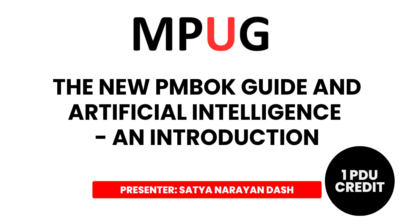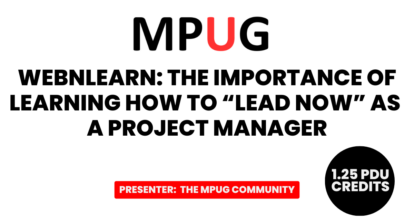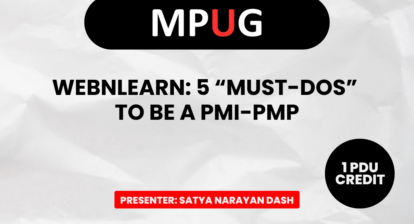The Project Management Professional (PMP®) examination offered by Project Management Institute (PMI) is changing next year. PMI first made this announcement in June of 2019 and has made the new Examination Content Outline (ECO) available for aspiring PMPs.
Why the Change?
Project management as a profession is increasing in complexity. It is evolving to meet new challenges of this century—rapid technological changes, expectations and aspirations of a new generation of workers, and of course, new methodologies and practices pertaining to Agile and/or DevOps, which are now mainstream.
PMI understands the shifts taking place in project management. In fact, every three to five years, PMI conducts a Role Delineation Study (RDS) or Job Task Analysis (JTA), which checks the knowledge, skills, and tasks required to perform the role of a project manager. This RDS or JTA, in turn, impacts the creation of the ECO due to the RDS providing the blueprint for the exam. PMP exam questions obviously link to the role of the project manager, so shifts are unavoidable. The final blueprint for the exam is documented in the ECO. This is depicted in the below figure.
The ECO is crucial because questions in the PMP exam are mapped against the ECO. The ECO mentions the domains on which exam takers will be evaluated, the tasks that are supposed to be performed in these domains, and also the knowledge and skills that are needed for project managers performing these tasks. The expected percentage of questions that will come from each domain is also outlined in the ECO, so that the right number of questions are in place for a valid PMP exam.
The last time such a study was conducted was in 2015. It resulted in changes to the exam in 2016. The current year’s study has resulted in the new ECO, and hence the PMP exam from July 2020 onward will change.
Important Dates
If you are an aspiring PMP, you should be aware of the following dates.
Looking at the above table, you can see that exam takers have to continue with the current ECO 2015 till June 30, 2020. However, if you plan to take the exam on July 1, 2020, or after, you have to follow the new ECO of 2020.
Overall Changes
Now that we know the change process for the PMP examination and we’ve covered the important dates, let’s get to what the changes actually are.
Change #1: Domains
The current PMP exam is based on five domains, which are outlined in the current ECO. The domains are:
- Initiating: Outlines the processes to define a new project or a new phase of an existing project and have the needed authorization to start off.
- Planning: Outlines the processes to establish the scope of the project, refine objectives on scope, time, cost, quality, etc. and informs on how these objectives will be achieved.
- Executing: Outlines the processes to complete the work defined in the project management plan, which is created in the Planning domain.
- Monitoring and Controlling: Outlines the processes to track, review, and control the progress and performance of the project and manage corresponding changes.
- Closing: Outlines the processes to finalize all activities across all process groups to formally close the project or phase or contract.
The new PMP exam will be based on three domains, which are outlined in the new ECO. They are:
- People: Emphasizes the skills and activities associated to effectively lead a project team (conflict management, team building, mentoring, etc.).
- Process: Reinforces the technical aspects of managing a project (scope management, schedule management, cost management, etc.).
- Business Environment: Highlights the connection between projects and organization strategy (benefits delivery and management, organizational change management, etc.).
You could say that the new PMP Exam will be standing on these three legs or (performance) domains.
Change #2 Percentage of Questions
The percentage of questions coming from each domain in the current exam is shown below.
In the new ECO of 2020, there is more of a focus on the Process domain, followed by People, and finally Business Environment.
The distribution of questions across domains is significant, as it impacts exam preparation and time that exam takers will be spending on each domain.
Change # 3: Tasks
Each domain in the ECO is associated with a set of tasks. In the 2015 ECO, the Initiating domain had eight tasks and the Planning domain thirteen. In the new ECO, too, each domain is associated with a set of tasks. The People domain has fourteen tasks, the Process domain has seventeen tasks and so on. The differences are noted in the below table.
The tasks are important because exam evaluation will be on these tasks on three scales. The score from each of these tasks will, in turn, be rolled-up to give the rating earned in each domain. This will be explained further in The Impact of the Changes section of this article.
Change # 4: Type of Questions
In the new exam, one can expect around half of the questions in predictive project management approaches and the other half in Agile/hybrid approaches. In the latest edition of the PMBOK Guide, these approaches are clearly defined and used across the process groups and knowledge areas.
The Impact of the Changes
Obviously, as the exam is changing, there will be many impacts that will occur. Let’s look at them one by one.
Impact #1: Exam Complexity
Many are saying the new exam will be more difficult, which I don’t agree with because the needed experience level to appear for the exam has not changed. It still is either of the following:
- For a four-year bachelor’s degree or global equivalent: Minimum of three years/36 months of unique non-overlapping professional project management experience,
– or – - For secondary degree (high school diploma or global equivalent): Minimum five years/60 months unique non-overlapping professional project management experience
As the experience level is relatively low and remains unchanged, I don’t expect the exam questions to be tougher. That said, the exam will be more complex because of the new addition of tasks within the new domains increasing the scope of coverage. If you are an aspiring PMP, you will need to expand your horizon in the project management landscape.
Impact #2: First Score Report
The first examination score report will be changed. This is the report exam takers get immediately after the exam at the exam center. It will be based on the three domains and the report will come as shown below.
The proficiency levels, nevertheless, remains unchanged, in that the score will continue to have four performance rating categories (Above Target, Target, Below Target, and Needs Improvement).
Impact #3: Detailed Score Analysis
For each domain, there will be tasks, and for each task, there will be another layer of evaluation.
As I’ve noted earlier, the ECO is important because evaluation is based on these tasks. For each, the scales used are “high,” “medium,” and “low.” For example, a detailed report for the tasks will be as shown below.
In the example I’ve provided, the candidate, for the People domain, has scored medium in Task 1, whereas for Task 2, the candidate scored high. Similarly, it will be for the tasks in other domains – Process and Business Environment.
Impact #4: Questions in Agile/Hybrid Approaches
As noted earlier, there is equal distribution of questions with respect to predictive and adaptive (Agile) or hybrid approaches.
These will be spread across all of the domains, People, Process, and Business Environment.
PMI Talent Triangle and the New ECO Triangle
If you look closely, you can find that the three domains in the ECO are aligning closely with the three arms of PMI’s Talent Triangle. The PMI Talent Triangle was introduced in 2015 because technical project management skills for a practicing project manager were found to be insufficient to succeed in the real world with real life practices. Hence, two new areas were added (leadership capabilities and strategic and business management proficiency). The PMI Talent Triangle is depicted on the left side of the diagram below.
Similarly, the new ECO of 2020 has three domains, which are aligned with real-world project management practices. I’ve put these three domains as the arms of the “New ECO Triangle” for easier correlation – shown on the right side of above diagram. Comparing these two triangles, you could say that:
- The “Power Skills” arm maps to “People” domain,
- The “Technical Project Management” arm maps to “Process” domain, and
- The “Strategic and Business Management” arm maps to “Business Environment” domain.
This is significant because if you are taking the new PMP exam, you need to evaluate your understanding in these contexts.
We now know what are the changes and impacts. Next, let’s dive a bit deeper into the domains and associated concepts of the new exam.
Domains, Tasks, and Enablers
Each domain in the new ECO is empowered by a set of tasks and enablers. In fact, in the new ECO the format of Domains, Tasks, and Enables is used throughout. I’ve depicted it in the below figure.
As shown, every domain has a set of tasks, and each task is associated with a set of enablers. Let’s look at some examples.
Domain: A domain is defined as the high-level knowledge area that is essential to the practice of project management.
- An example of this is People.
Tasks: A task informs about the underlying responsibilities of the project manager within each domain area.
- Examples (for the People domain) are:
- Task 1: Manage conflict
- Task 2: Lead a team
- Task 3: Support team performance
- …
Enablers: Enablers are illustrative examples of the work associated with a task. For example, for Task 2 (Lead a team) under the “People” domain, we have these enablers:
- Enabler 1: Set a clear vision and mission
- Enabler 2: Support diversity and inclusion
- Enabler 3: Value servant leadership
- Enabler 4: Determine an appropriate leadership style
- …
In simpler words, you can say that each answers a different question, as shown below.
In the last few months since the new exam changes have been announced, I’ve received a number of questions from aspiring PMPs who are using PMP Live Lessons – Guaranteed Pass, 35 Contact Hours PMP Program, and/or the I Want To Be A PMP book to prep for the exam. I’ll address a few of the most common in this article.
Frequently Asked Questions
Question – 1: As the domains are changing, will a new PMBOK Guide be available with the new domains?
Answer: No. The PMBOK Guide has not changed. The 6th edition of the guide will remain as is with its five process groups (outlined in the performance domain of the 2015 ECO).
Question – 2: Should I refer to the current edition of the PMBOK Guide and/or any other resource?
Answer: You have to refer to the current edition of the PMBOK Guide for your PMP exam preparation irrespective of taking the exam before or after June 30, 2020.
The PMBOK Guide is one of the main references that is used for PMP examination preparation. There are other references that can be used though. The questions are created by project management practitioners who are not solely bound by the PMBOK Guide.
- If you plan to take the exam before June 30, 2020:
- Use the current ECO of 2015 to understand the domains and tasks.
- The fabric of your PMP preparation material should be woven around its content.
- If you will be taking the exam after June 30, 2020:
- Use the new ECO of 2020 to understand the domains, tasks, and enablers.
- Ensure that the material that you are studying is aligned with the new ECO and that the content is woven around the three domains.
Question – 3: Do I need to remember the new tasks and enablers?
Answer: No. It is not necessary that you remember them, but you have to understand what they are and how they are mapped to the contents of the PMBOK guide and other project management references to become a certified project management professional.
Question – 4: How much should I focus on the Agile aspects?
Answer: Agile is obviously 50% of the exam as mentioned earlier in this article. With 100 questions, you need to have a sound knowledge of Agile approaches.
Question – 5: Should I read the Agile Practice Guide?
Answer: Yes. If you are going for the exam after June 30, 2020, I would suggest that you read the Agile Practice Guide, which comes bundled along with the PMBOK Guide, 6th edition.




















Walter Stinnett
PMI just announced, last week, that they are postponing the implementation of the new exam until July 1, 2020
Robin Nicklas
Thank you! This is a very clear, well organized and thorough explanation of the changes in the PMP exam.
The most important takeaway is your point that the exam is based on the Role Delineation Study (RDS) and not the PMBOK, per se. The candidate should be asking, for a given domain and for a particular task with certain required skills, what questions could be asked? Memorizing the inputs, tool, techniques and outputs of the PMBOK processes may not be sufficient preparation for the exam.
With the RDS evolving to just three very broad domains, I am having difficulty differentiating whether the scope of the exam is about management generally, or about project management specifically. It brings up the question whether project management is a separate profession or just a set of tools that every general manager needs to know.
What are your thoughts on where the RDS is evolving?
The MPUG Community
Thanks for the heads up, Walter! The dates and information in the article have been updated accordingly.
Satya Narayan Dash
Thank you Robin. The link of the PMP Exam with RDS and ECO has been there for a long time. Candidates are evaluated with the blueprint of the ECO – the domains, tasks, knowledge and skills.
If you look at the new ECO, the PMBOK guide is still very much referred and majority of questions will be from the PMBOK guide. PMI has recently given a crossover map – from ECO 2015 to ECO 2020.
As you can see, the croosover map is comparing individual tasks (with the new ECO, enablers have come in).
I don’t have much information on the future of RDS. Perhaps, we will know more in coming months.